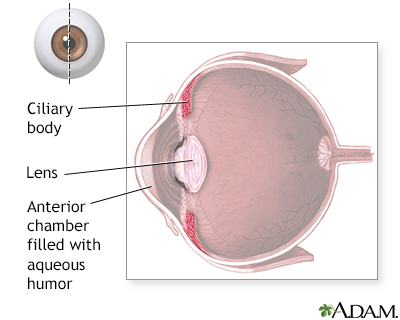Ciliary body
The ciliary body is a circular structure that is an extension of the iris, the colored part of the eye. The ciliary body produces the fluid in the eye called aqueous humor. It also contains the ciliary muscle, which changes the shape of the lens when your eyes focus on a near object. This process is called accommodation.
Iris
The iris is the colored part of the eye. It is located between the cornea and lens. The round, central opening of the iris is called the pupil. Ve...

Reviewed By
Franklin W. Lusby, MD, Ophthalmologist, Lusby Vision Institute, La Jolla, CA. Also reviewed by David C. Dugdale, MD, Medical Director, Brenda Conaway, Editorial Director, and the A.D.A.M. Editorial team.
Evans M. Anatomy of the uvea. In: Yanoff M, Duker JS, eds. Ophthalmology. 6th ed. Philadelphia, PA: Elsevier; 2023:chap 7.1.
Standring S. Eye. In: Standring S, ed. Gray's Anatomy: The Anatomical Basis of Clinical Practice. 42nd ed. Philadelphia, PA: Elsevier; 2021:chap 45.
Disclaimer



 All rights reserved.
All rights reserved.